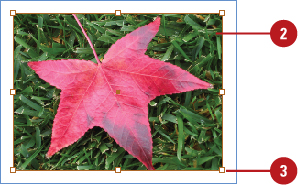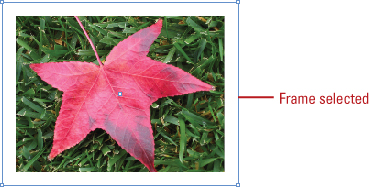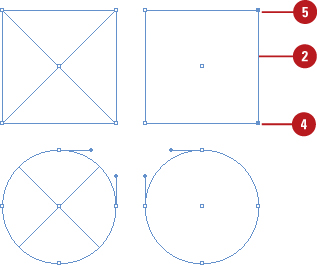With the Direct Selection tool, you can select a point on an object or graphics inside an object. When you point to (New!)
or select an object with the Direct Selection tool, path and anchor
points appear on the corners of the frame to make it easier to identify
and view. You no longer need to select an object to select an anchor
point. You can hover over the object to show the anchor points and drag
to change the shape of the frame. With the Direct Selection tool, you
can also select a graphic. There are two bounding boxes around a graphic
frame. One for the frame (blue) and another for the graphic (brown).
You can select the frame or graphic. When you select the frame, anchor
points appear. When you select the graphic, square resizing handles
appear on each corner and midpoint line. When you select a graphic, the
Direct Selection tool works like the Selection tool.
Select a Graphic with the Direct Selection Tool
- 1. Click the Direct Selection tool on the Tools panel.
The cursor becomes a white arrow. When you point to a graphic, the cursor changes to a hand.
Timesaver
Press A to select the Direct Selection tool.

- 2. Position the hand cursor on the graphic, then click to select it.
Square resizing handles appear on each corner and midpoint line of the object.
- 3. Use any of the following to work with the selected graphic:
- To move the graphic in the frame, drag the graphic.
- To resize the graphic, drag the resize handles.


Select an Object and Anchor Points with the Direct Selection Tool
- 1. Click the Direct Selection tool on the Tools panel.
The cursor becomes a white arrow. When you point to a selectable point, a
black dot appears near the white arrow. When you point to a selectable
edge, a small line appears near the white arrow.
Timesaver
Press A to select the Direct Selection tool.

- 2. Position the arrow on the edge or fill (if present) of the object and then point to (hover over) (New!) or click to select it.
- You can also drag a marquee across all or part of the object to select the entire object.
Small square anchor points appear on each corner.
- 3. To move an anchor point, drag it to another location.
- 4. To select an anchor point, click the small square point to select it.
The anchor point becomes solid.
- 5. To add or subtract anchor points or segments from the selection, hold
down the Shift key, and then click unselected items to add them or
selected items to subtract them from the selection.

Did You Know?
Selecting graphics is different.
Double-clicking graphics with the Selection tool no longer switches to
the Direct Selection tool; it selects the content frame (New!).
|